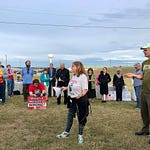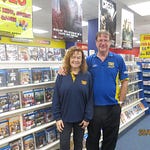Hi,
Thanks for the 100+ comments you left under last week’s “I was shot with two arrows — first in my stomach, second in my chest — by a man in the depths of the jungle”.
Your musings on life and death — and your own experiences and thoughts on it, made for amazing reading. I was so happy to get Matt’s essay out, and your responses made it even better.
Matt dived into the comments section too, which is also a dream: Having a writer come in to answer questions in realtime shows how special the community aspect of Webworm can be.
Thanks to the reader who wrote this:
“Paraphrasing, but ‘not near death but giving it a high five’ is a totally beautiful line. After a couple of wake up calls (not arrows to the diaphragm) in the last few years of my 30s, I’m aware now that:
1. Perceived intelligence is not a good way to judge a person’s character.
2. Government benefits are actually rarely abused in the scheme of things. Yes there are people/families entrenched in the system, and the system is flawed but we simply cannot function as a society without it.
3. Māori and Pasifika people know how to send their loved ones off the best.
Pakeha (I’m one) can learn a lot. Thanks Matt and David!”
Today I wanted to talk a little bit about P22, the mountain lion that was euthanised over the weekend. I’ve also recorded this as a podcast you can listen to.
It had been captured in someone’s backyard (not very far away from my apartment) — the city of Los Angeles keen to take it in for assessment after it’d had shown some pretty major behavioural changes.
Born in 2009, the mountain lion was first captured in 2012 and fitted with a tracking collar (hence P22 — the P is for Puma) to keep an eye on his movements and behaviour.
And in recent weeks, both had changed.
And that was worrying.

The photo above, taken on a remote camera by photographer Steve Winter, shows what made P22 so special: It was a big fucking cat living in the middle of Hollywood.
Coming from tiny New Zealand, LA will always feel like an overwhelming city to me. There are 3.8 million people here (New Zealand has about 5 million, total). The freeways terrify me, people are being shot and overdosing on fentanyl — and yet in the middle of this city there’s a mountain lion running around.
I first remember being made aware of LA’s “wild” side in one of my favourite film’s — Michael Mann’s Collateral.
There’s a moment when Tom Cruise and Jamie Foxx’s characters stop for a moment to observe a coyote running across the road. I can’t watch it without getting goosebumps or tearing up, a combination of so many of my favourite things coming together (including Chris Cornell’s voice):
It’s an all-time great scene — and so when I found myself in LA with my own coyote in the backyard of the house I was staying in, well — yeah. I knew this is where I needed to be right now.
Kinda like in the movie (but minus Tom Cruise), we laid eyes on each other — and for a moment we both just stopped.
I also learnt there’s a love hate-relationship between humans and nature in Los Angeles. As the city grows, wildlife like coyotes end up roaming further for food — and that often means spending more time in urban areas.
And in groups, coyotes get cocky. In the last few weeks, one walked up behind a toddler, grabbed the back of the kid’s jacket, and started dragging them off down the road. The kid was fine — dad stepped in — but it was a harrowing moment regardless. You can watch the news report below (just again: it’s scary; parents proceed with caution).
P22 was captured because he’d gotten cocky, too. Actually — cocky is what someone who hates animals would say. What’s accurate is that P22 was getting desperate.
Earlier in November, it had eaten a chihuahua that was being walked around the Hollywood Reservoir. The city of LA took notice, as the big cat was roaming in areas it didn’t normally roam in.
Mountain lions are meant to have a range of about 150 miles. P22 had about 9 miles, largely confined to Griffith Park (Adele did a concert at the top of Griffith last year. P22 probably listened).
The mountain lion existed on an island of shrubbery, trees and grass — an island surrounded by motorways in a city of 6.4 million cars.
This was never going to end well.
P22 had habits, and they’d changed.
Between the chihuahua and a number of other incidents, the California Department of Fish and Wildlife decided they had to step in. There were theories as to what had happened, including an anonymous call that a large cat had been hit on the freeway.
After an entire decade, one of those 6.4 million cars had struck the one mountain lion that existed in Los Feliz.
Fish and Wildlife tracked P22 down to someone’s backyard (according to a friend who texted me, “That mountain lion was caught in my New Zealand friend’s cousin’s backyard!), where it was taking shelter in some long grass.
They put P22 to sleep with a tranquiliser dart, the whole process captured by the homeowner.

Looking at the metal crate they carried him away in reminded me of the opening scene of Jurassic Park, as the velociraptor arrived. In this case, it was P22 leaving. And he wouldn’t be coming back.

A Facebook group I’d joined, P22 Mountain Lion of Hollywood, posted a message indicating the mountain lion wouldn’t be killed. Some of the language in the post bugged me, as it pointed out that P22 had enjoyed a happy long life already. While that was true, I was reading between the lines.
Unfortunately, there was a serious health issue: A direct hit from a fucking car.
What vets found wasn’t great. Being hit by a vehicle, and years of being stuck in a small, challenging environment had taken their toll:
Health exams revealed that P-22 weighed about 90 pounds, a loss of nearly one-fourth of his usual body weight. The big cat had a skull fracture, an injury to his right eye, herniated organs and a torn diaphragm, said Dr. Hendrik Nollens, vice president of wildlife health at the San Diego Zoo. Doctors also discovered P-22 had heart, kidney and liver disease, a thinning coat and a parasitic infection.
And with that news — P22 was put down.
The fact he had survived for over a decade was a small miracle.
Born in the Santa Monica Mountains, he’d walked to Griffith Park over two massive freeways and made his home there. He was alone in Los Feliz for 10 years with no mate — largely staying in Griffith Park where he’d munch on deers, raccoons and rabbits. Sometimes he’d wander into the city.
A friend roasted me by sending me this:
Many Angelenos saw themselves in P-22, an aging bachelor who adjusted to a too-small space in the big city, waiting for a mate who might never arrive.
My fellow sad bachelor had paced down my street many times — but despite all my walking, I’d never had a personal encounter myself. But people’s doorbell cameras would sometimes spot him — and he was a regular on neighbourhood Facebook groups.
A friend of a friend, Jacob Bixenman, was lucky enough to see P22 up close:
I’d sum it up by saying this whole thing sucks. And I’m part of the problem.
Mountain lions were here in LA before humans decided to move here to make movies. And podcasts.
We moved here knowing the risks that would be posed to us by wildlife. What we thought less about was the risks we’d pose to them. Because we never think about that stuff. We just do whatever the hell we want and all else be damned.
I was reminded of this again recently when talking to Rob Chaney for Flightless Bird — the author of The Grizzly in the Driveway: The Return of Bears to a Crowded American West.
In that book, the journalist looks at why bears and humans are having an increasing number of interactions — largely thanks to humans happily busting into the bears natural environment.
“What we’re talking about is a relationship. The bear is a thing that you can get your hands on (literally!), or it can get its claws on you.
But we’re also talking about nature as an agent in our lives.
And whether we believe we’re in a dominant position where we have dominion over the earth — and all that flies and crawls on it as the Bible likes to say — or we’re in something of a more equal, or maybe even a subservient, status with forces on the planet that are perfectly capable of killing us at a moment’s notice.
Whether you’re talking about a lightning strike on a golf course, or a flood that takes out two thirds of Pakistan in an afternoon, or a grizzly bear that shows up in your driveway.”
Rob told me it’s a matter of assessing our place in the world — in the food chain, “and its forces and powers of dominance and subservience”:
“The bigger issue is that we just seem to jump on the idea that we’re in control of it all.
That that everything is a giant terrarium with some levers and knobs — and we just we turn the temperature up a little bit, or we back off the humidity, or we turn the lights down to suit our immediate need, without realising that we might actually be the species in the terrarium.
And we’re not in control of knobs.”
As he told me about brown bears and grizzlies, I was thinking about P22:
“We’ve already colonised those river bottoms and those pastures and those good feeding areas, and then covered them with sheep and cows and dogs and llamas and chickens — and then we’re surprised when something else looks at it says, ‘Is that available for my lunch?!’”
He sees it as a risk management problem — a term often used in insurance.
“We’re building houses in places where wildfires occur, and then we just sort of assume that a fire department will show up and save our house if the wildfire gets too close.
But we didn’t provide for a fire department that is capable of putting out a wildfire. We don’t have enough retardant bombers, guys in yellow and green shirts and helicopters to put out these fires.
We just are gambling that we’ll get lucky and somebody else’s house will burn down.”
He pauses, before going on.
“We are gambling that if we want those free range chicken eggs, that a grizzly bear won’t show up and tear the chicken coup apart.”
What it comes down to is a reassessment of what it costs to do the things we want to do. The whole reason we have insurance is that we are banking money against losing a bet on doing something we wanted to do.
We’re not banking that money on building these houses in grizzly country, or in wildfire country, or in earthquake country, or in places where rivers are going to flood. And this gets back to that whole relationship with nature. We’re just betting that we won’t lose. And nature is running the table at the moment saying, “How is that bet working out?”
Right now, it’s not working out great. I think of the toddler being grabbed by a coyote. I think of P22 hit by a car on a freeway.
I think we humans still find it incredibly hard to grasp how much we’re ruining the planet — on both a grand scale of global warming, and also in our usual way of annihilating species one by one.
I think we find it very hard to grasp this, until we zero in on a simple story. Like P22.
There’s an amazing film I saw last night called EO — which just observes the life of a donkey. It’s beautiful and troubling — and demonstrates how when we see an animal, we only ever see and grasp a incredibly small part of its timeline and world.
But when you look at the entire life story of an animal, you see how much its life is dictated by the whims of uncaring humans. Or humans that care, but simply don’t have the time, power or resources to meaningfully help.
When I saw EO, all I could think about was P22.
There are positives in all this. In what humans are doing.
A giant wildlife bridge is under construction so wild animals have a chance to roam in their original habitats. Other mountain lions, in other parts of California, are also being observed, tracked and monitored.
But as for P22 — he was “compassionately euthanised” at 9am on December 17.
I just hope we learn enough to start caring a little bit more.
David.
PS: My friend George Byrne wrote a song about P22 years ago, when he was new to this city. I guess the mountain lion captured his imagination too, as he wrote a song about him. George hadn’t released it, but decided this was as good a time as any:


















Share this post